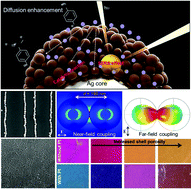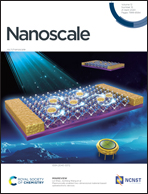Porosity-controllable magnetoplasmonic nanoparticles and their assembled arrays†
Abstract
Control of the chemical and physical properties of nanoscale colloids and their nanoassemblies remains a challenging issue for enhancing the performance and functionalities of nanodevices. In this study, we report a post-synthesis etching method to tailor the porosity of the Fe3O4 shells coating on Ag NPs, establishing a facile but effective approach to regulate the chemical and optical properties of the colloids and their assembled structures. As the shell porosity increases, the NPs are transformed, producing enhanced catalytic activity and the surface-enhanced Raman spectroscopy (SERS) effect, which results from enhanced chemical diffusion into the Ag core. Magnetoplasmonic (MagPlas) one- (1D) and two- (2D) dimensional arrays fabricated using these porosity-controllable NPs exhibit intriguing plasmon properties that are strongly affected by the porosity of the particle shell. Furthermore, the bright coloration of the 2D arrays is tuned by changing the shell porosity or introducing an additional metallic layer. Such 1D and 2D porous MagPlas metastructures possessing Fe3O4 shells with tunable porosities are a fulcrum for developing recyclable catalysts and tunable optical filters with optimized activity, selectivity, and sensitivity, as well as color displays and sensing platforms.



 Please wait while we load your content...
Please wait while we load your content...